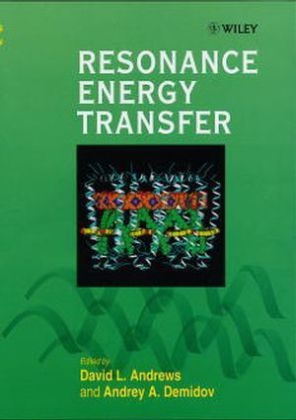
Resonance Energy Transfer
John Wiley & Sons Inc (Verlag)
978-0-471-98732-1 (ISBN)
- Titel z.Zt. nicht lieferbar
- Versandkostenfrei innerhalb Deutschlands
- Auch auf Rechnung
- Verfügbarkeit in der Filiale vor Ort prüfen
- Artikel merken
Resonance Energy Transfer
The resonance transfer of energy between molecules, or between sites within a large molecule, plays a central role in many areas of modern chemistry and physics. In biophysics, for example, this process defines the migration of excitation energy within photosynthetic systems (commonly the Frster mechanism). Another important area is in crystals, laser and other laser materials.
Resonance Energy Transfer contains a large amount of cutting-edge research which has never before appeared in book form. It is the first comprehensive modern survey of the field, offering a broad, yet detailed view of the mechanisms of energy transfer. The broad range of applications of fluorescence and fluorescence energy transfer to studies in molecular biology and biotechnology ensures that resonance energy transfer will be a vital component of the new science and technology of the next millenium.
This book is written for those working with materials, both experimentally and theoretically, as well as for biophysicists and biochemists interested in studying protein structure and dynamics.
ISBN 0 471 987328 (Cloth)
Foreword supplied by Professor Graham Fleming FRS, University of California, Berkeley, USA.
Cover shows the Peripheral Light Harvesting Complex (LH2) of Rps.acidophila kindly supplied by Dr. Stephen M. Prince, University of Glasgow, UK.
David L. Andrews, School of Chemical Sciences, University of East Anglia, GB. Highly respected and has made major interesting contributions in the field. His works are very deep and illuminating. Professor Andrews has also published in condensed matter QED, though not to the same extent. One of his books has gone to a third edition, and another has been reprinted.
1. Resonance energy transfer in proteins; introduction; some basic considerations; a short history of FRET determinations; the components of the Foorster equation; quantum yield; determining spectral overlap; steady state or time-resolved measurements?; resonance energy transfer using intrinsic amino acids; homotransfer between intrinsic probes; heterotransfer; the range of distances determined by resonance energy transfer; precise location of resonance energy transfer probes; properties of probes; labeling specific residues in proteins; resonance energy transfer experiments using lanthanide ions; measurements in radially symmetrical systems; comparison with crystallographic distances; using resonance energy transfer to constrain molecular models; resonance energy transfer with single fluorophores: new wave experiments; intramolecular energy transfer in proteins bound to membranes; green fluorescent protein; resonance energy transfer and biosensors: a new and promising technique; shortcomings; the future of FRET; summary; dedication; acknowledgements; references.
2. Unified theory and radiative and raditionless energy transfer; introduction; background; the basis of the unified theory; spectral features; refraction and dissipation; dynamics of energy transfer between a pair of molecules in a dielectric medium; conclusion; appendix A: Heitler-MA method for analysis of the transition operator;
Appendix B: modified approach to the transition operator; references.
3. Dynamics of radiative transport; introduction; overview of atomic and molecular radiative transport; the Holstein-Biberman equation; multiple scattering representation; stochastic approach; combined radiative and nonradiative transport; conclusion; appendix A: probablitity of emission of a photon between t + dt for an nth generation molecule; appendix B: depolarization factor for radiative transferaccording to classical electrodynamics; references.
4. Orientational aspects in pair energy transfer; introduction;
Kappa-squared and probability, Kappa-squared and anisotropy; notes on the effects of order and motion; acknowledgements; references.
5. Polarization in molecular complexes with incoherent energy transfer; introduction; interaction of light with single molecules or chromophores; bichromophore molecular complexes; trichromophore complexes; multichromophore complexes with C3 symmetry; conclusion; appendix A; appendix B; appendix C; appendix D; references.
6. Theory of coupling in multichromophoric systems; introduction; reactant and product states: LMO model; the origin of coupling matrix elements; paradigmatic results; coulombic coupling; superexchange; interpretation of steady state spectra; calculation of couplings; acknowledgements; references.
7. Exciton annihilation in molecular aggregates; introduction; theory; applications; discussion; acknowledgements; references.
8. Energy transfer and localization: applications to photosynthetic systems; introduction; optical properties of dimers and aggregates; energy and localization in antenna complexes and reaction centers; acknowledgements; references.
9.Excitation energy transfer in photosynthesis; introduction; the structure of light-harvesting complexes; the mechanism of energy transfer and trapping in photosynthesis; dynamics of excitation energy transfer; conclusions; acknowledgements; references.
10. The Fenna-Matthews-Olson protein: a strongly coupled photosynthetic antenna; introduction; steady state spectroscopy;
FMO exciton simulations;
FMO primary processes; epilog and future prospects; acknowledgements; references.
11. Use of a Monte carlo method in the problem of energy migration in molecular complexes; introduction; an illustration of Monte Carlo calculations in the problem of fluorescence decay; energy transfer in CME: major algorithm; applications of monte Carlo simulations; conclusion; acknowledgements; references.
Index
| Verlagsort | New York |
|---|---|
| Sprache | englisch |
| Maße | 160 x 238 mm |
| Gewicht | 936 g |
| Einbandart | gebunden |
| Themenwelt | Naturwissenschaften ► Chemie ► Analytische Chemie |
| Naturwissenschaften ► Chemie ► Physikalische Chemie | |
| Naturwissenschaften ► Physik / Astronomie ► Atom- / Kern- / Molekularphysik | |
| ISBN-10 | 0-471-98732-8 / 0471987328 |
| ISBN-13 | 978-0-471-98732-1 / 9780471987321 |
| Zustand | Neuware |
| Haben Sie eine Frage zum Produkt? |
aus dem Bereich


